Japanese Breakfast: Elevate Your Meal with Traditional Dishware
Oct 10,2017
Japanese Breakfast: Elevate Your Meal with Traditional Dishware
Oct 10,2017
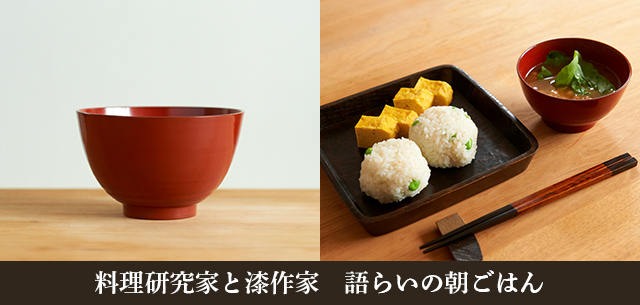
A breakfast conversation between a food researcher and a lacquerware artisan
A beaming smile greets us at the door of a chic Tokyo apartment. Upon entering, a spacious, enchanting room lies before us, in which Japanese furniture and exquisite lacquerware and curios meld impeccably with the space’s contemporary white tone.
This is the home of lacquerware artisan Miyashita Tomokichi and his wife Asuka. On this day, we are accompanying food researcher Sumida Maho and her husband Kazuhiko, who together operate the Sumiya food unit, on a visit to the Miyashitas’ home for breakfast.
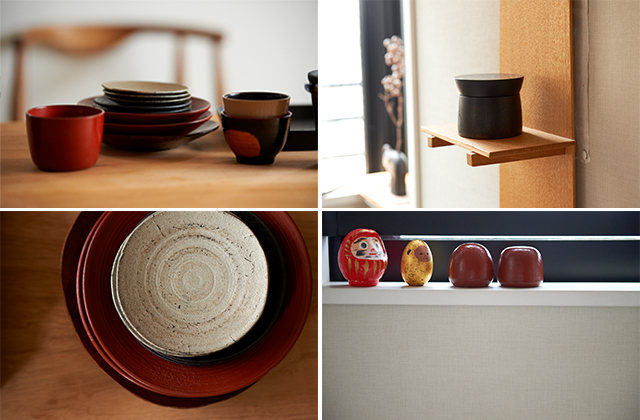
It may seem odd to be having breakfast at the home of a lacquerware artisan, but here’s how it came about. One day, we approached Sumida Maho and asked whether she would do an interview with us about breakfast and what kind of tableware she uses for breakfast, as Maho is both a food researcher and an art college graduate with detailed knowledge about tableware. She replied: “I have different things for breakfast depending on my mood and how I feel physically, but on days when I have miso soup for breakfast, I use a lacquer bowl. The bowls we use were made by a lacquerware artisan friend of mine, Miyashita Tomokichi. My husband and I have been friends with Miyashita and his wife for some 10 years. How about we all get together and have a conversation over breakfast?”
And that is how we ended up having breakfast at the Miyashitas’ home.
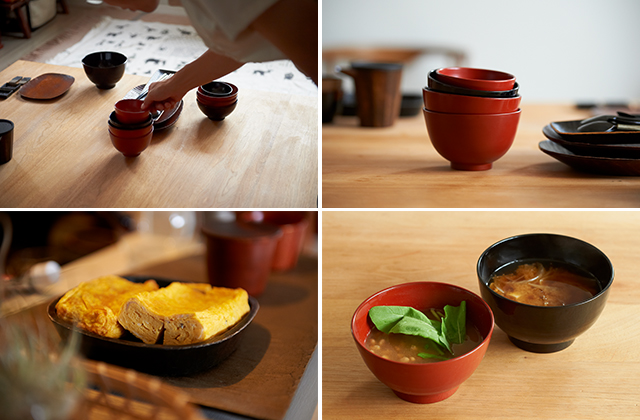
On that morning, the Sumidas prepared miso soup, while Tomokichi made onigiri [rice balls] and an omelette. Since the Sumida couple are cooks by trade, we had anticipated the delicious aroma wafting from the pot they had brought. But we were very pleasantly surprised to find that Tomokichi, the lacquerware artisan, had skillfully made onigiri and a beautiful omelette.
When we asked why he is such a good cook, Tomokichi replied: “Making breakfast and a lunchbox to take to the studio is part of my daily routine.” He quickly prepared bowls and plates for us and set the table. All the tableware — the bowls and chopsticks as well as the plates and chopstick rests — were lacquer-made. He commented on this: “I use the items I make on a daily basis to check their usability and durability. That’s why nearly everything on the table is lacquered.”
We had the impression that lacquerware is reserved for formal Japanese meals, but the Miyashitas’ everyday tableware has a soft, natural aura that welcomes any kind of cuisine.
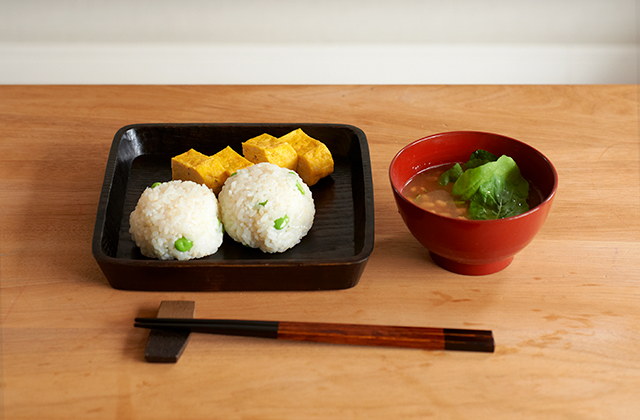
The Sumidas and the Miyashitas, together with their second daughter Kotono, gave a gesture of thanks before starting the two-family breakfast. Today’s breakfast consisted of miso soup with natto and arugula, miso soup with onion, onigiri with edamame [green soybeans], and an omelette. Everyone dug in while exclaiming how delicious it all was. Kotono, at just a year old, joyfully chewed on an onigiri.
As we ate, we first listened to the two families describe their miso soups.
Tomokichi:The first time I made miso soup after moving out on my own, I was disappointed that it didn’t taste anything like my mother’s miso soup. It was pretty terrible. I haven’t made it very often since then. So basically, my wife is responsible for the flavor of our family’s miso soup.
Asuka:That’s true. I often make miso soup with shijimi [freshwater clams] and tofu. I like combinations like onions and wakame seaweed or onions and potato that I used to eat a lot at my parents’ house. But these combinations are apparently foreign to my husband.
Kazuhiko:Miso soup with onions and wakame seaweed is a classic.
Maho:I don’t make that combination, personally.
The miso soup discussion continues about regional variations and how interesting home flavors are.

Maho said she selected today’s miso soup ingredients with summer in mind.
“Unlike my husband who can eat anything, even katsu [pork cutlet] curry, the moment he gets up, I can’t eat anything heavy in the morning. So, for me, an onigiri and some miso soup in place of a salad are perfect. If I add something like boiled spinach, it feels a little heavy. Especially in summer, the combination of quickly rinsed natto and tossed arugula is delicious. The aroma is refreshing as well. I also like to add a few budo sansho [grape Japanese peppers] to the classic miso soup with onions to freshen up the flavor.”
New to this taste, the Miyashitas smiled: “It’s very fresh.”
Maho continues: “I also recommend miso soup with asari clams and celery. It’s an excellent combo that people often use in pastas and soups. I think you can enjoy trying out whatever combinations suit your fancy with miso soup. I don’t use strong stocks very often. I occasionally use kelp as a stock, but in most cases, the umami from the vegetables and other ingredients is enough. In summer, when eating miso soup feels hot or heavy, I like using ooba [green aromatic shiso herbs] as a topping or adding ginger or some citrus fruit like sudachi or kabosu. Miso soup with sudachi or kabosu is often served as a local dish in Kyushu and Shikoku. It is a refreshing way to enjoy miso soup.”
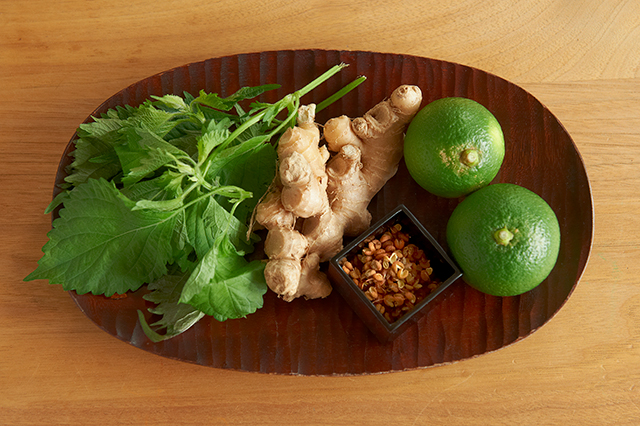
Maho usually eats weekday breakfasts on her own. After waking, she decides what breakfast to have after listening to what her body tells her it wants. She places great importance on what tableware to use and how her food is arranged.
“My favorite tableware gives me directions, in a sense. For example, if I decide on a certain bowl, then I consider how to make the vegetables look delicious, such as how to cut them and how long to make them. I had this habit long before I started this profession. Maybe I’m influenced by my parents, who ran a restaurant. Because I’ve always thought like this, it’s been very useful in my current job. Tableware has helped me develop my appreciation for food presentation.”
Kazuhiko echoed Miho’s words.
“We eat breakfast together on my days off. If I arrange the food on a dish or plate different from the one she had in mind, she’ll ask me to use a different dish or plate and I have to redo the arrangement. That’s how fussy she is. [laughs]”
But why is she so specific about tableware and the presentation of a meal? Maho’s answer was very precise.
“I think your ability to pull something off for a special occasion is built on your every-day practices. Even when it’s just us, or just myself, or even just breakfast, I enjoy picking out the tableware and cutting and arranging the food to look delicious. I think repeating this daily is key. For example, when serving a dish with red tomatoes and green peppers, the flavor is the same whether they are on the bottom where you can’t see them or on top where they look nice. But from a visual standpoint, the sensation of how tasty the dish looks is completely different. Arranging food to look delicious is a way of being attentive to the person eating the dish. I never want to overlook this feeling even when just making a meal for myself. That a meal looks delicious is extremely important before arriving at actual deliciousness. And it’s important to me that the people close to me and I are properly satiated by the first meal of the day.”
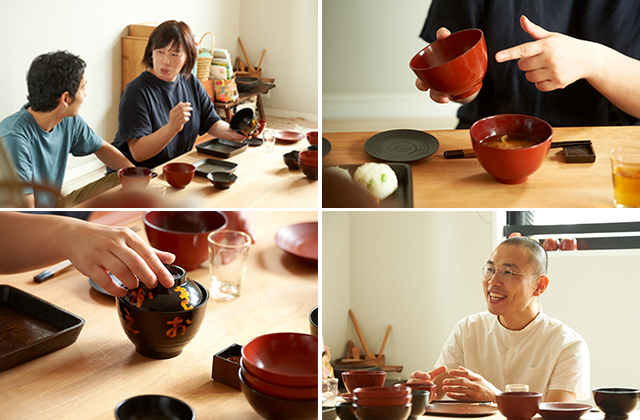
Maho bought the bowls she normally uses for miso soup from Tomokichi nearly eight years ago at an exhibition.
“I can’t use a bowl or plate that doesn’t feel right because they are things I use every day. I fell for Tomokichi’s bowls because they are natural and there’s nothing pretentious about them.”
The lacquerware-making process is usually divided into two separate stages done by different skilled workers: forming the unlacquered base wood into the final shape and applying the lacquer to the wood. Tomokichi, however, does everything himself, from forming the base to the finishing touches. Consequently, there are subtle changes in the shape and appearance of each piece he puts out.
Maho says: “The pieces really reflect Tomokichi’s state of mind at the time he crafted them.”
Tomokichi says with a laugh that Maho is able to tell right away which pieces he created while something was bothering him. “It’s truly a delight for me that there are people who pay close attention to my work. Naturally, I make my tableware with comfort and usability in mind. But on the other hand, if I make my pieces thinking solely about the user, I end up with something that doesn’t feel very good. Even if I have worries, I try to sincerely enjoy the process of making each tableware piece.”
Maho adds: “I probably won’t use tableware that has too much of the artisan’s worldview in it.” What she values is blank spaces.
She continues: “It’s the same thing when I create recipes. I create recipes that can be made and taste good with just simple ingredients, rather than recipes that require special spices or herbs to complete. Of course, you can customize my recipes and add herbs if you are so inclined. I consciously leave these kind of blank spaces in my recipes. I look for the same blank spaces in tableware as well.”
Maho picks up one of Tomokichi’s bowls and explains why it impressed her.
“There are some bowls that at a glance, I can imagine the flavor and presentation of the food in them. For example, when I first saw this lidded bowl from Tomokichi [a bowl decorated with the characters for a, i, u, e, and o] at the exhibition, I immediately got excited. It was fun and uninhibited. When you look at it, all kinds of images come to mind. Recipes come to me inspired by tableware. This bowl is that type of bowl. In the end, I didn’t get this bowl, but I want to be a cook who can make dishes that match this bowl. I remember feeling at the time that I really wanted to make something that matched the feeling of this bowl.”
Food and tableware bring out the best in each other. The two couples’ conversation over breakfast conveyed their devotion to their professions. Mornings are often a busy time of day. But if you slow down a little and enjoy breakfast in your favorite tableware, you just might start your day with more fulfillment.

Food researcher
Food researcher
Along with her husband Kazuhiko, Maho operates the Sumiya food unit. Her activities center on catering and writing books. She has earned a reputation for her recipes that use basic seasonings found in every home and that soothe both the body and soul. She is the author of Kihon Chomiryo Dake de Tsukuru Mainichi no Kondate to Okazu [Everyday Meals and Side Dishes Made with Only Basic Seasonings] (Mynavi Publishing) and co-author of Hayauma: Ichiju Issai [Fast & Tasty: One Soup, One Side] (Shufu-To-Seikatsusha).
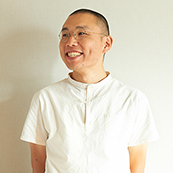
Lacquerware artisan
Lacquerware artisan
1979 Born in Okaya, Nagano prefecture
2006 Graduated in Lacquer Art from the Faculty of Fine Arts, Tokyo University of the Arts
2008 Completed a graduate course majoring in Lacquer Art from the Graduate School of Fine Arts, Tokyo University of the Arts
2009 Research student majoring in in Lacquer Art from the Graduate School of Fine Arts, Tokyo University of the Arts
Presently working in the Tokyo region
Director of the Japan Lacquerware Association for Cultural Properties
Part-time lecturer in Lacquer Art (intensive course) at the Faculty of Fine Arts, Tokyo National University of Fine Arts